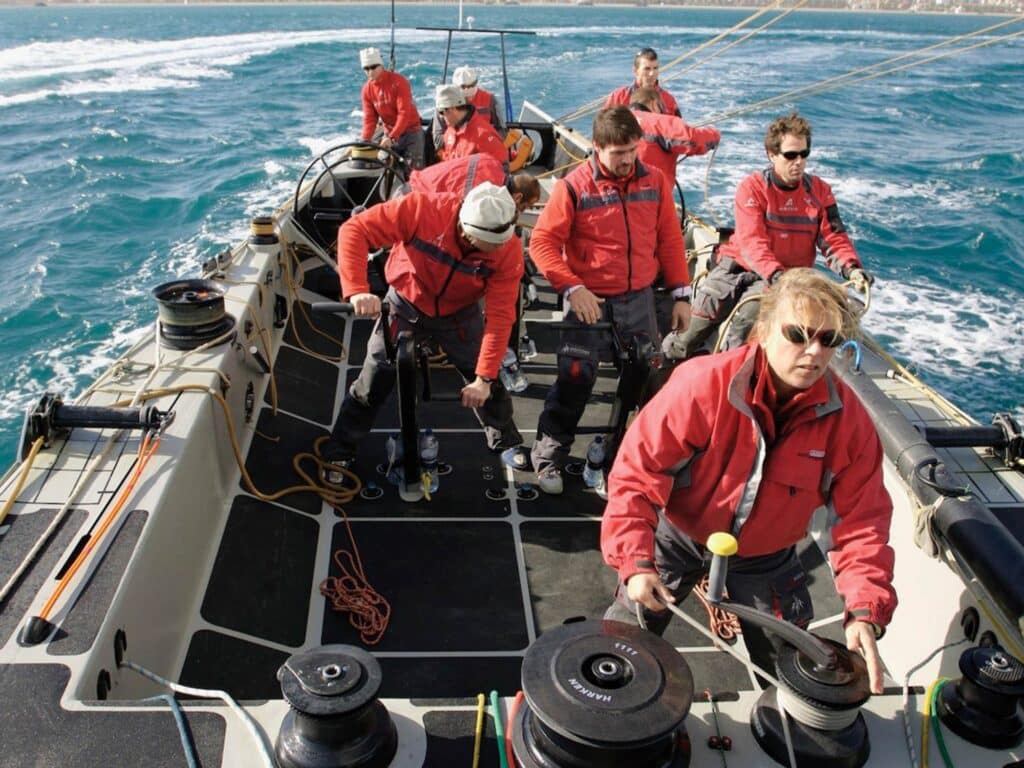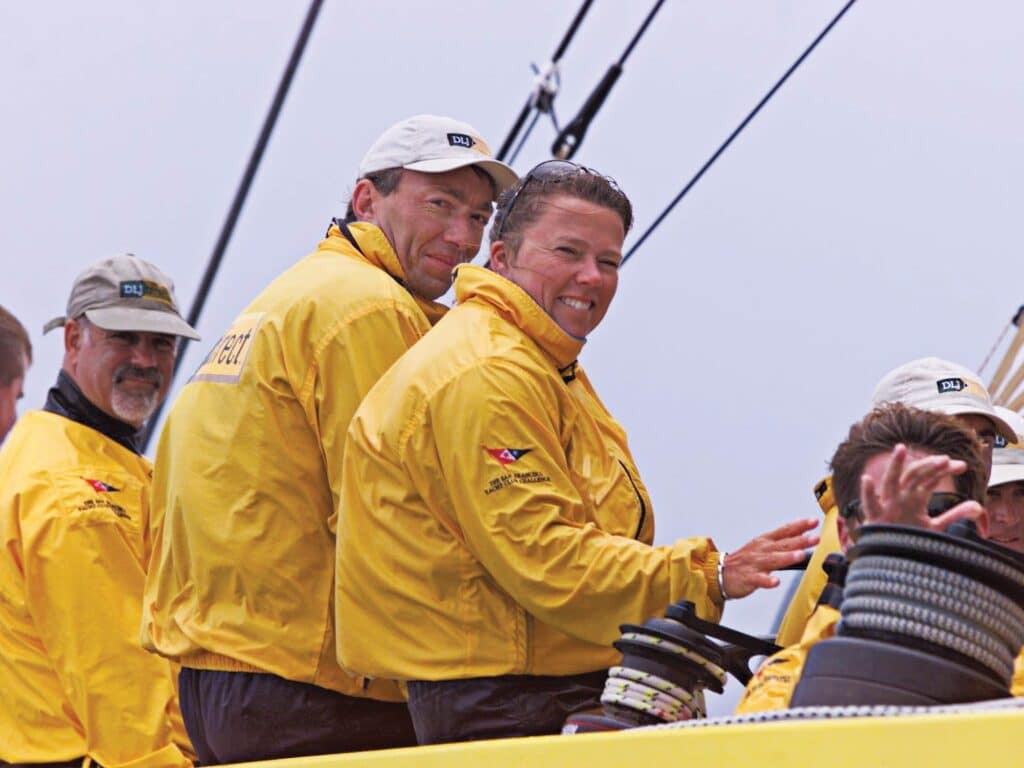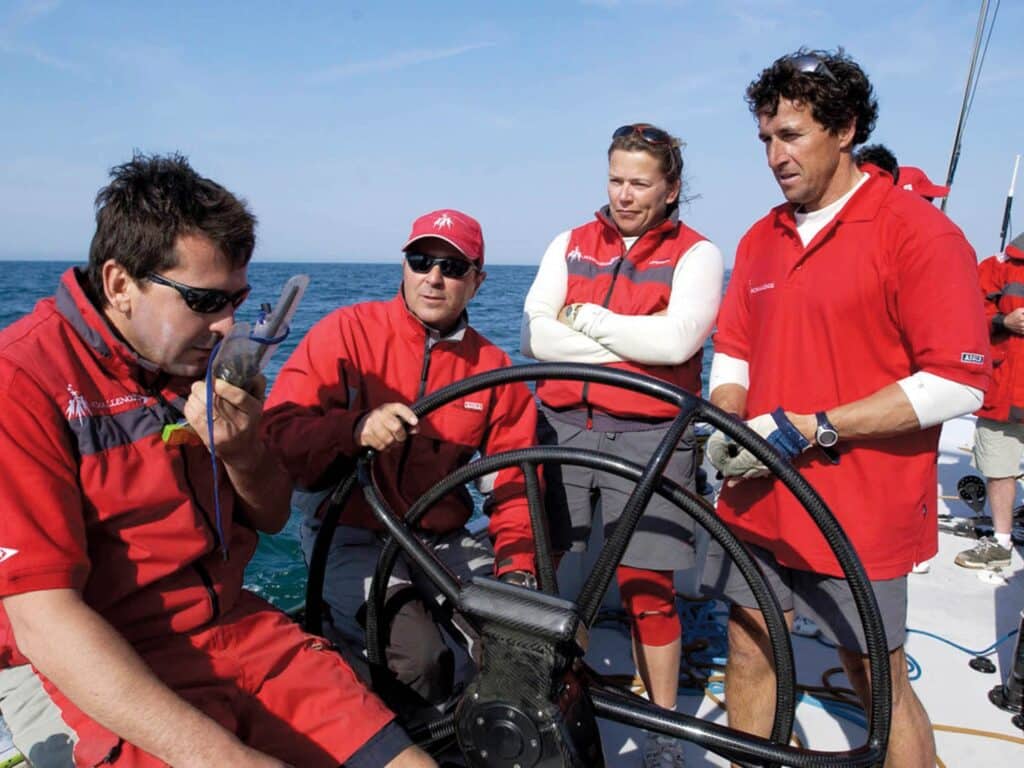
Dawn Riley has been an ambitious sailor and tireless advocate for women in sailing since her earliest days. She has raced in the America’s Cup and in grueling around-the-world races. Riley is skilled, determined and friendly. These attributes have carried her a long way.
She grew up as the oldest of three children in Detroit. Her parents, Chuck and Prudence Riley, were strong promoters of her quest to be the best in her sport.
Riley was named Rolex Yachtswoman of the Year in 1999 for winning in fleet- and match-race disciplines. Riley has won One Ton Cup and Women’s Match Race World championships. She got an early break five years after graduating from Michigan State University by joining the crew of Maiden, an all-women crew who competed in the Whitbread Round the World Race.
The story of that harrowing race was portrayed beautifully in the 2019 documentary Maiden. Riley was one of the crew in the film. At the time, it was a first for an all-women crew to take on such a challenging race. They won the toughest leg: the Roaring Forties in the Southern Ocean. The crew enjoyed their fame and finished the leg from Uruguay to Florida wearing swimsuits. When Maiden approached the finish line off Cowes, England, the wind was light as the sun peeked over the horizon. A lone sailboat passed, circled around, and started following Maiden. Within an hour, hundreds of spectator craft were escorting the heroes of the Whitbread to the finish line.

Finishing the Whitbread must have been a sweet moment for Riley. When she was 14 years old, she declared publicly that she was going to sail in the America’s Cup and race around the world. These were bold aspirations for a junior sailor out of the North Star Sail Club near Detroit. Eleven years later, she was doing it.
After the Whitbread race, her career took off. In 1990, Bill Koch was organizing a bid to defend the America’s Cup for the San Diego Yacht Club. Koch thought it was a good idea to include a woman on the crew. When Riley’s name was suggested, Koch gave her a tryout. In 1992, his syndicate America3 successfully defended the America’s Cup. Riley now had an America’s Cup on her resume too.
In 1993, Riley was asked to take over as a skipper for another round-the-world race. The boat was sponsored by brewer Heineken, which was hoping for a better performance. Riley signed on, added a few crew, and at age 30, had a second around-the-world race on her resume.
At this point in her career, Riley told her story in a book called Taking the Helm, written with Cynthia Goss. The narrative is an account of the 1993-94 Volvo Ocean Race (formerly known as the Whitbread). Riley shows readers the difficulty of competing in long-distance races. She wrote reports about the struggles via a new communication technology, CompuServe.
“We have had a really bad break,” she wrote. “Last night we were sailing with our smallest running spinnaker and a reef in the main. I was in my bunk when I heard a huge bang and felt the boat broach violently. …We are now wallowing along in 35-foot seas and 40 knots of wind with only the storm jib up and trailing warps [off] the transom, trying to control our drift in the general direction of England.”
Riley also wrote an elegant essay about the fury of sailing around the sailor’s feared nemesis Cape Horn, which is reputed to be the windiest part of the world. Gale-force winds whip past the Caape one out of every four days. Riley was poetic in her observation as they sailed past: “Yes, there is a science to sailing around the Horn, but in the realms of dreams and myths, it’s as if something is alive down there. Maybe there is a huge ghost of Cabo de Hornos, with seaweed hair and crazed eyes the color of the sky during a storm. Maybe he sits on a perch on the legendary rock wall. Maybe he gets bored. Maybe he looks down at the tiny sailboats passing by and says, ‘OK, you little sailboat out there, I am going to have some fun with you now.’ He points a gnarly finger, takes a deep breath, and blows. The sea turns into a raging torrent of white water. And then he laughs.”
When asked what can be done to encourage more women to race offshore, Riley says: “We need to make sure women are out there and are in good positions on the crew. When you are away from land and there are only 10 people on the boat, then there are 10 people; it doesn’t matter if they are male or female. There are absolutely no jobs women can’t do. You can do whatever you want. Scientifically, whether you are male or female, if you have the same weight and work out, you have the same strength. There are no physiological differences.
“I work out five days a week, ever since I was 15 years old. I lift weights some days, and do aerobics other days. I am moving every day.”
To prepare for offshore sailing, she has a routine. “Before the race, I try to get plenty of sleep. I make sure that I am hydrated. It is important to be as healthy as possible and not have a cold or be sick. It is important to prepare your kit so that you have all the proper foul-weather gear and clothing.
“Another thing I do is visualize the race and think about what it is going to be like, how long it is going to be, and what kind of conditions we might see,” she adds. “So if something happens, I am ready. Most women are very good at concentration. I find that women are so happy to be on board, they are going to put in an extra effort to prove themselves.”
After the 1992 America’s Cup, Riley skippered her own team to victory in the Santa Maria Cup match-race championship. Three years later, she was Team Captain for the all-women’s America’s Cup team aboard Mighty Mary. The team just missed qualifying.
One of her assets is being a diligent note-taker. She learned many lessons that proved more than helpful when she launched her own campaign, America True, in 2000 for the America’s Cup in New Zealand. The team advanced to the semifinal round. For the 2007 America’s Cup in Valencia, Spain, she was the general manager of the Areva Challenge, based out of France.
Riley is a champion of mixed sailing, which means men and women on the same boat. “I’ve seen an all-male crew because I have been the only woman on the team, and I have been on mixed teams,” she says. “I love mixed teams. The dynamic is different, but it is a more complete team. You’ve got enough different perspectives that you have better decision-making capability.”
She is also dedicated to helping others. After working for Hillary Clinton’s presidential campaign in 2007-08, Riley seriously considered running for Congress. Then, New York financial executive Hunt Lawrence recruited Riley to run Oakcliff Sailing. Lawrence’s vision was to create a high-performance training center for sailors who have progressed beyond traditional coaching methods. Oakcliff has a fleet of boats that prepares young sailors for offshore sailing, match racing and the Olympic Games.
“The last frontier, in my opinion, for women in sailing is in decision-making roles, not just leadership,” Riley says. “Leadership without power is not decision-making. Women in leadership with decision-
making powers is where we need to go. The next step is
for more women to own their own boats.”
On land, Riley can make a four-course gourmet meal from a virtually empty refrigerator. She is also a gardener who concentrates on vegetables, fruits and herbs. “Anything that reduces going to the grocery store makes me happy,” she says.
She also has been there for me personally. In 2003, she and I were commentators for a TV preview of the America’s Cup regatta on San Francisco Bay. I had spent the previous six months battling lymphoma, and this was my first outing after months of chemotherapy. One night, I was unable to get myself over to the studio. She stopped by my hotel, saw me in excruciating pain, and had the good sense to call an ambulance. Four days later, I flew back to Maryland and started the process of a stem-cell transplant. I will be always be grateful that she came to my rescue at a low point in my life.

Riley had some bad luck herself one evening in her rented home in Oyster Bay, New York. The house was positioned alongside a sharp curve in the road. She was eating dinner and reading emails at her dining room table when a pickup truck came careening around the corner, lost control, and smashed through the front of the house. Riley suffered a concussion and other injuries. It would be months before she recovered. She had the resolve to get back to her important work—and back on the water.
Today, she is in constant motion as a sought-after speaker for yacht clubs and corporate events. She has served on many boards, including the Women’s Sports Foundation, founded by tennis great Billie Jean King to expand opportunities for girls and women in sports. Riley served as president in 2003 and 2004, the only sailor to lead the organization. Other boards where she has served include the US Sailing Association, America True Youth Program, National Sailing Hall of Fame and National Women’s Sailing Association. I was president of US Sailing when Riley joined our board of directors. She never missed a meeting, was well-prepared, asked good questions, and had suggestions that made a difference in our approach to administrating the sport of sailing.
She was inducted into the National Sailing Hall of Fame in October 2021. At the ceremony, she spoke about how she hopes her experiences serve as an example of what young sailors can achieve.
Riley has been an inspiring leader her whole life, setting a high standard as a competitor and manager in sailing. Many years from now, it will be clear that her persistent advocacy will have advanced the skill level of many sailors and encouraged more women to spend time on the water.
Adapted from an excerpt in Gary Jobson’s soon-to-be-released book titled Characters of the America’s Cup.








